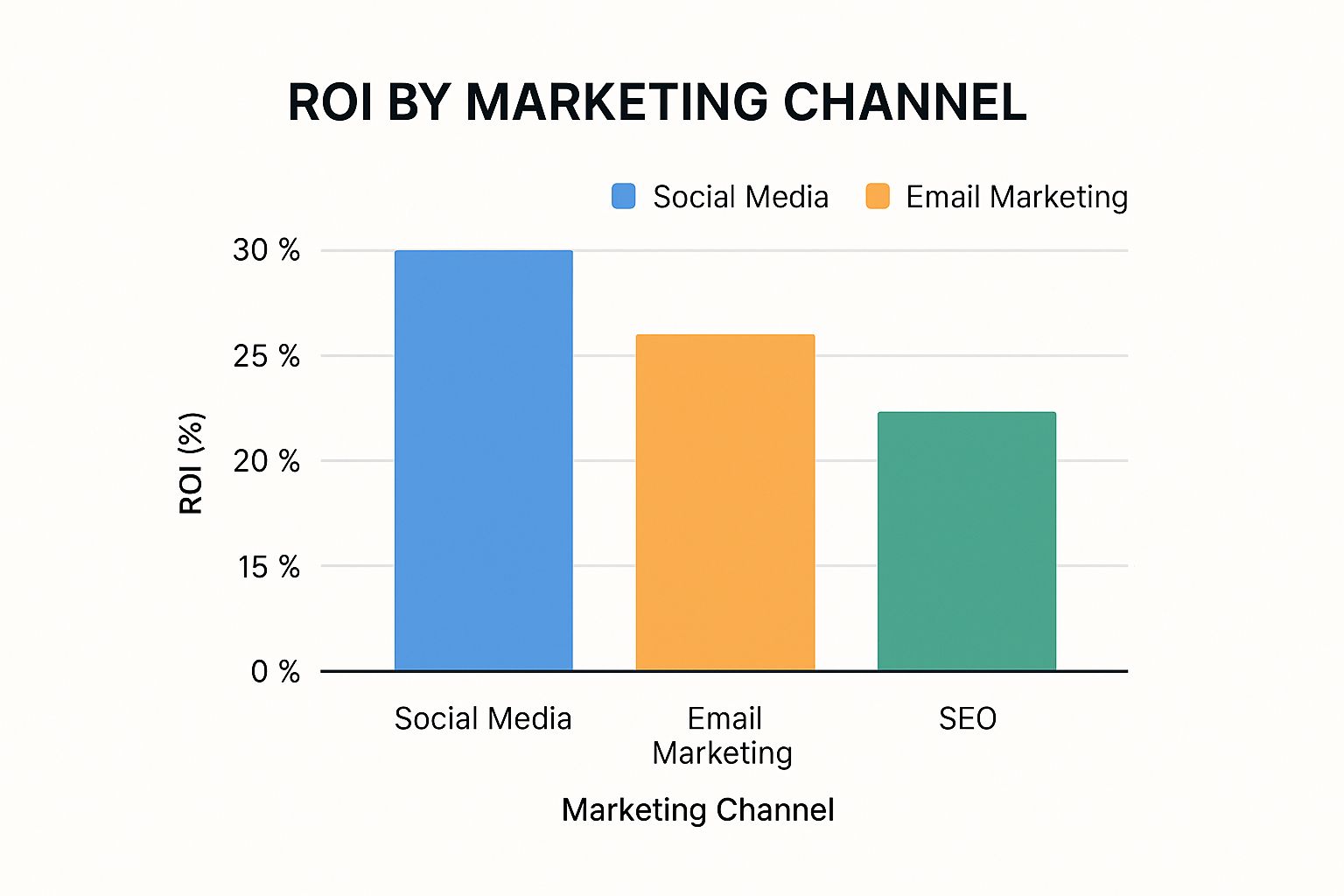Why Your Marketing Budget Is Your Secret Growth Weapon
Let's be honest, treating your small business marketing budget like an afterthought will stifle your growth. I've chatted with tons of UAE entrepreneurs, and the successful ones get it: they see their marketing budget as a smart investment, not an expense. It's a mindset shift – seeing marketing as fuel for growth, not just a cost. I've seen local businesses double their revenue simply by changing this perspective.
This mindset is key, especially in a fast-paced market like the UAE. So many small businesses accidentally hold themselves back by underspending or spreading their resources too thin. They're always reacting to immediate needs instead of proactively planning for the long haul. This reactive approach usually means missed opportunities and a constant uphill battle.

This Wikipedia screenshot shows just how important SMEs are to the world economy. The point is that even though SMEs often have limited resources, their impact is huge, which just reinforces the need for strategic marketing.
Recognizing the Warning Signs of an Underperforming Budget
How can you tell if your current budget is holding you back? Here are a few red flags:
- Flat or shrinking sales: If your revenue isn't growing, your marketing probably isn't working hard enough.
- Low customer acquisition cost (CAC) but low customer lifetime value (CLTV): You might be attracting customers for cheap, but if they don't stick around, your profits will suffer in the long run.
- Outdated tactics: If your competitors are thriving online and you're still only using traditional methods, you're missing out.
- Can't measure ROI: If you don't know how your campaigns are performing, you're essentially guessing.
Fixing these problems means fundamentally changing how you approach your marketing budget. It's not about spending more, it's about spending smarter. This is especially important with the increasing digitization of marketing budgets for small businesses in the UAE. While big companies dominate the regional marketing agency market right now, SMEs are the fastest-growing segment, expected to grow by about 7% every year between 2024 and 2029. Learn more about the MENA marketing landscape.
Turning Your Budget Into a Growth Engine
Think of your marketing budget like a well-oiled machine. A smart budget helps you:
- Connect with the right customers: Instead of trying to reach everyone, you can focus on your ideal customer.
- Build a strong brand: Consistent, strategic marketing makes your brand recognizable and builds loyalty.
- Get ahead of the competition: Smart investments give you an edge in a crowded market.
- Grow sustainably: A well-managed budget lets you reinvest profits for even more growth.
By seeing your marketing budget as an investment, you can turn it from a cost into a major driver of growth. This proactive approach is what separates successful businesses from the rest.
Discovering Your Perfect Marketing Investment Sweet Spot
Forget those generic marketing budget formulas. Finding the right investment for your small business is a much more personalized process. I've spoken with numerous successful business owners across the UAE, and their experiences really highlight this. One Dubai tech startup, for example, allocated 25% of their revenue to marketing during a period of rapid growth. Meanwhile, a well-established retailer in Abu Dhabi maintains steady growth by investing just 8%.
So, what's the real takeaway here? Your ideal marketing investment isn't a fixed percentage; it's a reflection of your unique situation. Factors like your current growth stage, the competitiveness of your industry, and even the overall market conditions here in the UAE all play a crucial role. A maintenance budget for a stable business looks completely different from a growth-focused budget for a startup. And if your business is seasonal, like many in the UAE's tourism sector, your annual planning requires a whole different approach altogether.

This Wikipedia screenshot provides a general overview of what goes into a marketing budget. The important thing to remember is that a budget isn't just a number; it's a plan. It encompasses your strategy, your spending, and, most importantly, your projected results.
Avoiding the Biggest Budgeting Mistake
The biggest mistake I see small business owners make is basing their marketing budget on what they think they can afford, instead of what they need to achieve their goals. This often leads to underspending, which, ironically, can end up costing them more in the long run because of missed growth opportunities.
Instead of thinking about what you can afford, start by thinking about your desired outcomes. Where do you see your business in six months? A year? Five years? Once you have those goals in mind, work backward to figure out the marketing investment needed to get there.
Let's say you're launching a new product in Dubai. Think about the market penetration you'll need to hit profitability. How many customers do you need? What marketing activities will help you reach them (social media campaigns, influencer collaborations, local events, etc.)? Realistically, what will those activities cost? This forward-thinking approach, while maybe more challenging initially, sets you up for much greater success.
Growth vs. Maintenance: Two Different Ball Games
It's also crucial to understand the difference between a growth-focused budget and a maintenance-focused one. If you're trying to rapidly expand, like that Dubai tech startup we talked about, you'll likely invest a higher percentage of your revenue in marketing to acquire customers quickly and build your brand.
But if you're already established, like the Abu Dhabi retailer, your marketing spend might be lower, focusing more on keeping your current customers happy and building loyalty. Your strategy shifts from aggressive acquisition to nurturing the relationships you already have.
Your industry's competitive landscape also matters. If you're in a highly competitive market, like the Dubai F&B scene, you'll likely need to invest more to stand out from the crowd. This might involve targeted advertising, PR efforts, or creative partnerships. If your competition is less intense, you might achieve your goals with a smaller budget.
To illustrate these differences, let's look at some budget guidelines:
To help visualize these differences, take a look at this table:
Marketing Budget Guidelines by Business Stage
Recommended marketing spend percentages based on business maturity and growth goals
| Business Stage | Revenue Percentage | Monthly Budget Range (AED) | Primary Focus |
|---|---|---|---|
| Startup (New/Launch Phase) | 15-25% | 5,000 – 20,000+ | Brand awareness, customer acquisition |
| Growth Phase (Expanding rapidly) | 10-15% | 7,500 – 15,000+ | Market penetration, scaling campaigns |
| Established Business (Maintaining market share) | 5-10% | 2,500 – 7,500+ | Customer retention, loyalty programs |
| Mature Business (Stable, focusing on profitability) | 2-5% | 1,000 – 5,000+ | Brand building, targeted promotions |
As you can see, the marketing budget shifts significantly depending on where your business stands. Startups invest heavily in initial growth, while mature businesses focus on maintaining profitability.
Thinking Seasonally and Strategically
Seasonal businesses, especially prevalent in the UAE with its tourism cycles, require a different budgeting strategy. Instead of spreading your budget evenly across the year, you'll want to concentrate your spending during your peak seasons. This means syncing your campaigns with things like influxes of tourists or key shopping periods. A desert safari operator, for example, would likely ramp up marketing during the cooler months, while a retailer might focus on promotions during Ramadan and Eid.
By understanding these nuances, you can build a small business marketing budget that's more than just a number—it becomes your strategic roadmap for growth. It's all about finding that perfect investment sweet spot, where your marketing spend perfectly aligns with your business goals and the realities of the market.
Smart Budget Allocation That Actually Drives Results
Allocating your marketing budget wisely is key, especially for small businesses. Think of it like carefully watering your plants – you want to give each one just the right amount to flourish. I've seen firsthand how the right approach can make all the difference. For example, a friend who owns a bakery in Abu Dhabi found that focusing 60% of her budget on Instagram ads, paired with beautiful food photography, brought in a flood of new customers. It worked because her target audience was actively engaged on the platform. On the other hand, a business consultant I know in Dubai invests more in LinkedIn and networking events, which makes sense for his B2B focus.
The 70-20-10 Framework and How to Adapt It
Many successful business owners use the 70-20-10 framework as a starting point:
- 70% on Proven Channels: This is your bread and butter. Invest in the strategies you know work. This might be Google Ads, Facebook Ads, or email marketing – whatever has consistently delivered results for your business. Testing smaller campaigns within these channels can validate their continued effectiveness.
- 20% on Experiments: This is where you get to play! Try out new platforms like TikTok or influencer marketing. Think of it as calculated risks. You’re exploring potential new avenues for growth.
- 10% on Emerging Opportunities: This is your "rainy day" fund for unexpected chances. Perhaps a sudden industry trend or a viral challenge you can capitalize on.
Remember, this framework is a guide, not a rigid rule. A fashion boutique might allocate more towards Instagram and visual platforms, while a software company might prioritize content marketing and SEO.
Let's look at a potential breakdown across different business types. The table below illustrates how you might adapt your spending based on your specific industry:
Smart Budget Allocation Framework
Channel-by-channel breakdown showing optimal spending distribution for different business types
| Marketing Channel | Retail Business % | Service Business % | E-commerce % | ROI Timeline |
|---|---|---|---|---|
| Paid Search (Google Ads) | 20% | 30% | 25% | Short-term/Long-term |
| Social Media Advertising (Facebook/Instagram Ads) | 40% | 20% | 45% | Short-term |
| Email Marketing | 15% | 25% | 20% | Short-term/Long-term |
| SEO | 15% | 15% | 5% | Long-term |
| Content Marketing (Blog, Videos) | 5% | 5% | 3% | Long-term |
| Local Advertising/Events | 5% | 5% | 2% | Short-term |
This table offers a general guideline. Your individual allocation will vary, so keep experimenting!

This infographic visually reinforces the need for a balanced approach. A solid marketing strategy considers the strengths of various channels.
Hidden Costs and Staying Agile
Don't forget those sneaky hidden costs! Things like software subscriptions (HubSpot), design tools like Canva), or the time it takes to manage your campaigns. Not factoring these in can throw off your entire budget. For a deeper dive into social media ad costs, check out our guide on social media advertising costs.
Just as important as planning is flexibility. Market trends shift, and customer preferences change. Being able to adjust your budget quickly is essential. Digital advertising is a prime example. In the UAE, small businesses are increasingly investing in digital ads. In 2023, the MENA digital ad market hit US$6.64 billion. Projections show it reaching US$44.83 billion by 2032, growing at a 23.9% CAGR between 2024 and 2032. Learn more about digital advertising growth.

Tools like Google Analytics are invaluable for tracking your website traffic. This data shows you what's working and what's not, allowing you to tweak your budget accordingly. By analyzing where your visitors are coming from and what they're doing on your site, you can invest in the channels delivering the best return.
By staying adaptable, you can effectively navigate the marketing world and allocate your budget for maximum results.
Maximizing Impact While Minimizing Waste

This Wikipedia screenshot gives a good overview of affiliate marketing. Look at how it shows the connections between merchants, affiliates, and consumers. This highlights how small businesses in the UAE can use existing networks to reach more people without massive ad spending.
Let's talk about stretching your marketing budget as a small business. It's not about being cheap, but about getting smart. I've seen amazing things from entrepreneurs here in the UAE. One consultant in Dubai built a thriving business on less than AED 2,000 a month for marketing. His secret? Focusing on relationships and real value. I know another retailer in Abu Dhabi who actually beat competitors with way bigger budgets. She did it with well-timed promotions and partnerships with businesses that complemented hers.
Leveraging Free and Low-Cost Tactics
There are so many ways to get your name out there without spending a fortune. Think about boosting your organic social media reach. That means interesting posts, relevant hashtags, and actually talking with your followers. Build a community, don't just shout into the void. And don't forget local connections. Networking events, Facebook groups, sponsoring local things…these build relationships and create buzz.
Looking for smart ways to do more with less? Check out this resource on smaller marketing budgets. It's packed with practical tips.
Negotiating, Identifying Budget Drains, and Building Referrals
Haggling with suppliers is a game-changer. Don't be shy about asking for discounts or looking at different vendors. Every dirham you save is a dirham you can use elsewhere. Also, regularly check your spending. Are you paying for software you never use? Is print advertising not giving you a return? Cut the fluff.
Happy customers are your best ads. A strong referral system is key. Give them reasons to tell their friends about you – discounts, special perks, you name it. Word-of-mouth is gold, especially in the UAE. And speaking of referrals, think about affiliate marketing. The affiliate marketing scene in the Middle East and Africa (including the UAE) is already worth USD 370.24 million and expected to grow at a 7.7% CAGR. It's all about performance, perfect for businesses watching their wallets.
Shifting Your Mindset
Making the most of a small marketing budget isn't just about tricks. It's a mindset. See the possibilities, not the limits. Always ask, "How can I do this with less?" That drive, paired with the right moves, gets big results, even on a small budget. It's how small businesses win in a competitive market like the UAE, especially with the digital world growing so fast.
Measuring What Matters: Beyond Pretty Numbers
Let's face it, getting lost in a sea of analytics is ridiculously easy. But figuring out which numbers really move the needle for your small business marketing budget? That's the real challenge. I've chatted with countless business owners here in the UAE, and many have learned this the hard way. They were tracking everything imaginable but still couldn't get a clear picture of what was working. So, how do you cut through the clutter and zero in on the metrics that truly drive results?
From Vanity Metrics to Valuable Insights
It's not about chasing impressive-looking numbers. I know a consulting firm in Dubai that almost got completely distracted by a huge social media following. Sure, it looked fantastic on their reports, but it wasn't bringing in new clients. They wisely shifted their focus to Customer Lifetime Value (CLTV). By understanding the total value of each client over their entire relationship with the firm, they could make much smarter decisions about their client acquisition costs.
Another great example: A retail shop owner in Abu Dhabi told me she basically ignores most social media metrics. She keeps a close eye on foot traffic and repeat purchases instead. For her business, those are the golden numbers directly linked to revenue. It's all about what makes sense for your specific situation.
This screenshot from the Facebook Ads Manager shows a ton of data. But just looking at impressions and reach won't give you the whole picture. Dig deeper. What about website clicks, actual conversions, and the cost per acquisition? Those are the numbers that connect your ad spend to real business outcomes.
Simple Tracking for Real Results
You don't need complex software to track what truly matters. A simple spreadsheet can often do the trick! Track your marketing activities and the resulting sales. Start looking for patterns. Did a specific social media campaign lead to a jump in online orders? Did that email discount offer actually boost sales? Our guide on marketing campaign tracking can help you set up your own simple tracking system.
Early Warning Signs and Smart Pivots
Knowing when to change course is also key to managing your marketing budget. Watch out for red flags. Are your website visits dropping? Is your cost per lead suddenly going through the roof? These could be signs that your current approach needs tweaking.
Don't be afraid to play around with things. Test different channels and try new tactics. The important thing is to constantly monitor and adjust your approach. Think of your budget as a flexible tool, not something set in stone. What worked last quarter might not work this quarter. The market here in the UAE is constantly changing, so your marketing has to change with it.
By looking beyond the surface-level numbers and focusing on the metrics that genuinely affect your bottom line, you’ll be well on your way to making smart, data-driven decisions that maximize your marketing ROI. It's not about measuring everything; it's about understanding what truly matters for your business.
Adapting Your Budget Like A Strategic Thinker
Running a small business, especially here in the UAE, means your marketing budget needs to be as dynamic as Dubai's traffic. Forget rigid plans; think real-time adjustments and flexible thinking. You need to be ready to shift gears as the market changes.
I've seen firsthand how important this is. An events company I worked with shifted 80% of their budget to digital marketing during a tough period. They ended up finding a whole new, highly profitable audience online – a complete game changer.
Doubling Down, Cutting Losses, and Spotting Opportunities
When something's working, like an Instagram campaign that’s bringing in great results, pour some more fuel on that fire! Don't hesitate to invest more where you're seeing a strong return.
Just as important: know when to cut your losses. A tactic not performing? Don't keep throwing money at it. Be decisive, redirect those funds to something with more promise. It’s all about making smart choices.
Strategic thinking is also about spotting opportunities before everyone else. Is a new social media platform taking off in the UAE? Is there a local event perfect for reaching your target audience? Be proactive. Experiment. Especially if it aligns with your customer's behavior. For example, learning how to measure social media ROI will help you make better decisions.
Seasonal Adjustments and Mid-Campaign Pivots
Many businesses in the UAE are seasonal. This means your budget needs to ebb and flow throughout the year. If you’re in tourism, your marketing spend during peak season should be significantly higher than during the off-season. Makes sense, right? Capitalize on those tourists!
Sometimes, even mid-campaign, you’ll need to make a change. Maybe an ad isn't performing as expected, or a competitor launches a surprising campaign. Don’t be afraid to adjust. The ability to adapt is key to a successful marketing budget.
This Wikipedia screenshot shows the important parts of a marketing strategy: analysis, targeting, and the marketing mix. These elements should guide your budget decisions. A solid strategy helps you allocate your budget effectively across different channels.
Testing New Channels Without Risking Your Core Business
Experimentation is crucial, but it shouldn’t put your main business at risk. When trying a new marketing channel, start small. This lets you collect data and see how things perform without overspending.
For more ideas on business growth, you can check out our guide on growth strategies. If a new channel works, great! Gradually increase your investment. If not, you've minimized your risk and learned something valuable. By adapting your budget strategically, you’re setting yourself up to handle market changes and achieve real, long-term growth.
Your Complete Marketing Budget Implementation Guide
Alright, let's get down to brass tacks. This section is your toolkit for managing a small business marketing budget like a seasoned pro in the UAE. We'll cover everything from initial setup and monthly reviews to tackling common problems, using helpful tools, and knowing what to do when campaigns tank (or when amazing opportunities come knocking). Think of me as your friendly marketing mentor, sharing what actually works.
Setting Up Your Initial Budget
Grab a spreadsheet (or a budgeting app like Mint) and list your planned marketing activities. Next to each activity, put down your estimated costs and what you hope to get out of it. For example:
- Activity: Instagram Ad Campaign targeting new customers in Dubai
- Estimated Cost: AED 1,500
- Expected Results: 50 new leads
Don't be vague. This initial setup is like mapping out a road trip. The clearer you are, the easier it is to stay on course.
Monthly Review: Keeping Your Budget on Track
Setting a budget isn't a one-and-done deal. Check in on it every month. Compare what you actually spent and the results you got with your original plan. Ask yourself some key questions:
- Did I go over budget or come in under? What happened?
- Did I hit my targets? If not, what went wrong?
- What needs tweaking next month?
These monthly check-ins are your steering wheel, keeping you on the road to success.
Troubleshooting Common Budget Challenges
Here are some bumps you might hit along the way and how to navigate them smoothly:
- Unexpected Expenses: A little "rainy day fund" can be a lifesaver. Stashing away a bit extra can help cover those surprise costs.
- Underperforming Campaigns: Dive into the data. Is your audience targeting off? Is your message falling flat? Don't be afraid to pull the plug on something that's not working and try a different tack.
- Overspending: Look for places to trim the fat without sacrificing results. Maybe you can negotiate better rates with suppliers. Or perhaps there are free or cheap options to those fancy paid tools.
The key is to be adaptable. Things change, and your budget should be able to flex with them.
Essential Tools for the Modern Marketer
A few good tools can make managing your budget much less of a headache:
- Spreadsheet Software: Google Sheets or Excel are great for basic tracking.
- Budgeting Apps: Mint or YNAB can help you get a really detailed picture of your finances, both business and personal.
- Marketing Analytics Platforms: Google Analytics or your social media dashboards are your go-to for tracking how your campaigns are doing.
These tools are like having a financial GPS, providing valuable insights into where your money is going and what you're getting back.
Emergency Strategies and Unexpected Opportunities
Tuck away a small slice of your budget (say, 10%) for those “just in case” moments. A sudden hot trend, a competitor's blunder, or a viral challenge—these are golden opportunities. Be ready to jump on them! Just as important, have a backup plan if a campaign goes south. Know when to cut your losses and shift gears.
Realistic Timelines for Seeing Results
Not all marketing activities are created equal. Paid ads can bring in quick wins, while SEO is a long game. Understanding these differences will save you from disappointment. Building a solid brand takes time and steady effort. Think marathon, not sprint.
Take charge of your marketing budget, and watch your business blossom. With these practical tips, you’ll be well on your way to maximizing your ROI and building something that lasts.
Ready to take your online presence to the next level? Contact Technogital today. Learn how Technogital can help your business thrive.

